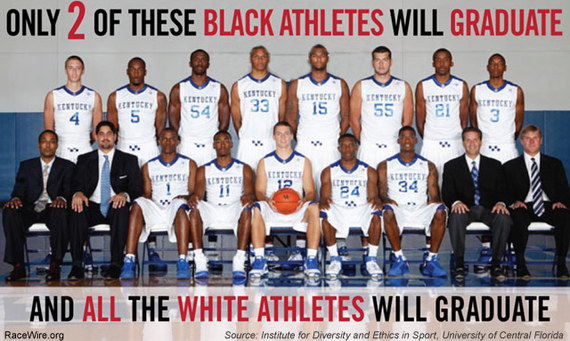There has been growing interest nationally over whether Division I colleges and universities should treat student athletes as employees and pay them accordingly for their highly regarded talent. On the heels of this ongoing debate comes a surprise ruling by the National Labor Relations Board (NLRB) allowing the Northwestern football players who receive scholarships to be considered university employees and, hence, eligible to unionize. Though Kain Colter, former Northwestern quarterback and current spokesman for the team's push to unionize, ensures that monetary compensation is not their main concern (but instead health care coverage, academic assurances, etc), it does raise the question -- should players receive financial remuneration for their role in a multi-billion dollar industry?
Those on one side of the debate believe that paying players would ruin college athletics. The National Collegiate Athletic Association (NCAA) responded to the recent NLRB announcement "stating that:
"This union-backed attempt to turn student-athletes into employees undermines the purpose of college: an education. Student-athletes are not employees, and their participation in college sports is voluntary."
The belief here is that players should compete solely for the love of the game where paying them would bring about an end to the innocence of their youth and change the dynamics between the players, coaches and other stakeholders.
On the other hand, critics point to the $10.8 billion deal that the NCAA inked with CBS/Turner Broadcasting just for the NCAA basketball tournament alone. The billions of dollars made in TV contracts, corporate sponsorships and apparel sales materialize through just two sports. The high-revenue sports of football and men's basketball are both enormously solvent and deliver the bulk of return on investments that provide the resources to fund other sports on college campuses.
Perhaps not ironically, African American males from disadvantaged communities and neighborhoods are overrepresented in both of these sports. One study noted that between 2007 and 2010, black male degree-seeking students made up just 2.8 percent of full-time undergraduates, but comprised 57.1 percent of football teams and 64.3 percent men's basketball teams.
And yet black males are significantly underrepresented in the academic side of the student athlete life. In other words, they are the least likely to complete their college education, even when it's "free." Academic success in college for black student athletes is challenging despite what the pundits say. Public education (K-12) and later colleges and universities have continually failed to address the racial inequalities that exist within their area of influence. Because public education in US society is unequally funded by local property taxes, the masses of young black males who reside in disadvantaged and deprived communities receive less funding and subsequently "get what they paid for" by receiving a sub-par education through no fault of their own. Nevertheless, these same unprepared black males are recruited to the university ranks solely based on their athletic prowess by the same institution that denied them entrance and full inclusion in the first place.
In fact, universities and colleges rely on black bodies to fill the coffers and to further the interests of whites through a coordinated system of black exploitation. This is not new in US society. Between 1619 and 1865, black muscle was used to build up this nations infrastructure and, in essence, its wealth. Black Americans were robbed of an estimated 222 million hours of forced labor, working from sunup to sundown in the fields, in the mines and other areas of backbreaking drudgery. Post-slavery America continued to use black men and women for their labor power for another 100 years of near slavery-like conditions during the sharecropping era of Jim Crow racism. Blacks often earned meager wages that would invariably fail to cover the cost of their living expenses, which further left them destitute and indebted to whites. Today, black student athletes in these high-revenue sports are quite similarly used for their brawn, as they receive the promises of unrealistic rewards.
This process starts at a young age for black boys. Growing up in a cycle of poverty, many young black men long for a shot at the professional ranks where their hopes and dreams of gaining financial independence for them and their families might finally be fulfilled. College athletics for many black males is a means to an end with the primary goal of making it to the pros. In reality, less than 2 percent of college athletes are drafted into the NFL and NBA. The alternative reward is the chance at a free education from the ivory tower. This is indeed enticing to causal observers. But to the 17, 18 and 19-year-olds from America's underprivileged neighborhoods, a college education is impractical and an improbable recompense for a multitude of reasons.
As former and current players of Northwestern University successfully demonstrated in their brief to the NLRB, Northwestern football occupies the majority of a players' time at an upwards of 40 hours a week with a highly regimented daily schedule from meal time to film study to practice. This is not particularly unusual; players nationwide put in an unreasonable amount of training time as they prepare to fill the seats in stadiums and arenas across the country. The message sent here by university and college stakeholders is "cultivate your brawn."
Yet, even more concerning is the lack of academic preparedness these student athletes arrive with on campus that is necessary to earn a valid degree. It is utterly self-serving on the part of the institution to recruit these players to campus with many lacking the basics reading, writing and arithmetic skills to successfully obtain a quality education. This is not to imply that all African American athletes are struggling. Public education, however, has uniformly failed black children, especially those from impoverished areas, as they essentially learn nothing of academic value in their formative years through primary and secondary school. These black student athletes have been racially primed for failure long before they arrive at the academy.
And so the argument becomes, if there is not enough time, manpower, or resources to fulfill the promise to provide these young men with a legitimate opportunity to earn an adequate education and degree, the least these corporations (colleges and universities) can do within this highly lucrative sports-industrial complex is pay them for the use of their bodies. Black athletes are literally used by the universities to increase the enrollment numbers, considering football and basketball success is often a primary reason for a student's choice of college attendance. Not only are these athletes maximizing tickets sales, but also tuition costs. Once again, blacks are used for monetary gain, of which they have no access; they do not own their own labor power. The black male athlete represents the "mule" in college sports, doing what he has been conditioned to do in society by serving white interests.
Black students athletes are recruited and admitted to white universities and colleges at a rate higher than black degree-seeking students who are non-athletes, which is telling about the worth and value that black men bring to the academy. This should not be unexpected given the history of centuries-old white supremacy directed at black Americans and the contemporary realities of that legacy seen in virtually every domain of society. Predominately white universities have found ways to admit unprepared black student athletes to campus that then find themselves disproportionately located in the athletic departments of most major Division I schools. But a recent report shows that the majority of black athletes either do not finish their degree or earn a degree that is not consistent with the rigors of the institution from which they come. The poor graduation rate for black student athletes at some of America's finest colleges and universities is indicative of the systemic failure of American public education and its continued racist practices of exclusion.
These young men (and women) deserve an exceptional education that will set them on a path toward excellence in an academic field. Short of that, compensation for student athletes of high-revenue sports would be a significant way to improve the college experience. Unionizing will allow student athletes to collectively bargain with the university for provisions unique to them and specific to their needs, such as long-term health care for injuries sustained on the field of competitive play and consideration for compensation. Because most black students athletes received a less than adequate primary school education, the university must bare the responsibility for effectively bridging the gap for students to ensure their success. And the monies that flow into the college and university system could be used to greatly enrich the lives of black men in American who live in the margins of society.

